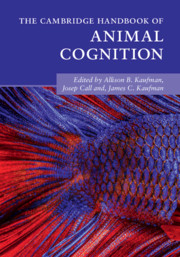Book contents
- The Cambridge Handbook of Animal Cognition
- The Cambridge Handbook of Animal Cognition
- Copyright page
- Dedication
- Contents
- Figures, Tables, and Boxes
- Contributors
- Acknowledgments
- Introduction
- Part I Communication and Language
- Part II Memory and Recall
- Part III Social Cognition
- Part IV Social Learning and Teaching
- 19 Social Learning and Teaching Overview
- 20 Tandem Running Recruitment by Temnothorax Ants as a Model System for Social Learning
- 21 Fish Social Networks
- 22 Social Learning in Birds
- 23 Social Learning in Chimpanzees
- Part V Numerical and Quantitative Abilities
- Part VI Innovation and Problem-Solving
- Index
- References
22 - Social Learning in Birds
from Part IV - Social Learning and Teaching
Published online by Cambridge University Press: 01 July 2021
- The Cambridge Handbook of Animal Cognition
- The Cambridge Handbook of Animal Cognition
- Copyright page
- Dedication
- Contents
- Figures, Tables, and Boxes
- Contributors
- Acknowledgments
- Introduction
- Part I Communication and Language
- Part II Memory and Recall
- Part III Social Cognition
- Part IV Social Learning and Teaching
- 19 Social Learning and Teaching Overview
- 20 Tandem Running Recruitment by Temnothorax Ants as a Model System for Social Learning
- 21 Fish Social Networks
- 22 Social Learning in Birds
- 23 Social Learning in Chimpanzees
- Part V Numerical and Quantitative Abilities
- Part VI Innovation and Problem-Solving
- Index
- References
Summary
Birds have contributed a great deal to our understanding of social learning. In this chapter we briefly review this extensive body of research, describing the contexts in which birds use social information to make behavioral decisions. We discuss the ecological factors that promote social learning, and the mechanisms by which social learning occurs. We consider individual differences in social learning, focusing on how learning strategies and biases influence when, how and from whom birds will learn. We examine the consequences of social learning for evolutionary processes, from the emergence of culture to speciation and adaptation to environmental change. Finally, we highlight how knowledge of social learning processes can be applied in the conservation and management of threatened bird species.
- Type
- Chapter
- Information
- The Cambridge Handbook of Animal Cognition , pp. 503 - 533Publisher: Cambridge University PressPrint publication year: 2021



